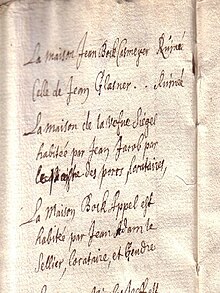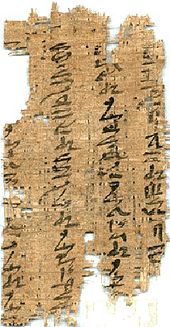Writing material
This article needs additional citations for verification. (June 2019) |

A writing material, also called a writing medium, is a surface that can be written on with suitable instruments, or used for symbolic or representational drawings. Building materials on which writings or drawings are produced are not included. The gross characterization of writing materials is by the material constituting the writing surface (for example, paper) and the number, size, usage, and storage configuration of multiple surfaces (for example, paper sheets) into a single object. Writing materials are often paired with specific types of writing instruments. Other important attributes of writing material are its reusability, permanence, and resistance to fraudulent misuse.
Early media
[edit]
Because drawing preceded writing, the first remains of writing materials are the stone walls of the caves on which cave paintings were drawn. Another precursor was tally sticks used to record the count of objects or the passage of days or other discrete units of time. Tally sticks have been found made of wood and bone. Knotted ropes and similar materials were also used for tallies. Such materials did not take a great deal of preparation for their use for drawing or writing. Animal hides also had potential for use as a material for writing or drawing, although the drawings and writings may have been decorative or to convey status or religious meaning. Among the barks of trees, birch bark is very well suited for use as a writing material and was used in Northern Europe and among native peoples in North America.
Four other classes of material were sometimes used for writing: clay, wax, cloth, and metal. The value of metal for useful implements may have made it less than useful for practical writing and drawing. The hardness of many metals that made them useful also made it an inconvenient material for many kinds of writing. But foils or sheets of soft metals like lead were usable. Lead sheets were used for curse tablets, as well as personal correspondence.

Writing seems to have become more widespread with the invention of papyrus in Egypt. Parchment, using sheepskins left after the wool was removed for cloth, was sometimes cheaper than papyrus, which had to be imported from outside of Egypt. With the invention of wood-pulp paper, the cost of writing material began a steady decline.
Cloth probably shared its mode of use with animal skins. Clay introduces the useful combination of extreme ease of making the inscription with the potential for rendering it fairly permanent. Unglazed pottery can readily accept inscriptions even after firing. Wax offers another novel combination of advantages: a reusable surface, easily inscribed and erased, and an easy combination with materials like wood that give it durability. Stone tablets, clay and wooden writing tablets, and wax-covered wooden tablets are some of the first specialized configurations of materials in flat surfaces specifically for writing.
Unglazed pottery shards were used almost as a kind of scratch paper, as ostraka, for tax receipts, and, in Athens, to record the individual nominations of Greek leaders for ostracism.
Papyrus was first used during the 4th millennium BC in Egypt. In the second century BC, it was replaced in parts of the Mediterranean by parchment made from treated animal hides. Parchments used skins from several different animals, and varied significantly in qualities like texture and color. Parchment was ultimately replaced as the result of the increasing availability of paper.
On the Indian subcontinent, principal writing media were bhurjapatra made from birch bark, and palm leaf manuscript. The use of paper began only after the 10th century.
In China, early writing materials included animal bones, later silk,[1] bamboo and wooden slips, until the 2nd century when paper was invented. The invention of paper is attributed to a eunuch of the imperial court called Cai Lun in 105 AD[1] However, paper was not introduced to Europe for another thousand years following a battle in 751 AD where a few paper-makers were captured, and thus the technology spread from Baghdad westward, only reaching Spain in the 12th century.[citation needed]
Paper
[edit]Cai Lun used old rags, hemp, tree bark, and fishing nets to develop a method of paper-making fundamentally similar to that still used today.[1]
The Islamic world acquired the art of papermaking in the 8th century, taught by Chinese prisoners who had been taken during eastward expeditions. Eventually, the Muslims brought papermaking to the Indian subcontinent and to Europe.[2] An early Greek name for paper was bagdatikos, meaning 'from Baghdad'. The craft of paper-making reached Spain in the twelfth century, and at subsequent hundred-year intervals arrived in Italy, Germany, and England. Yet for centuries after paper became widely available in Europe, vellum and parchment were preferred for documents that had to be long-lasting. The basic ingredients of paper were linen and cotton, soaked in water and beaten into a smooth pulp, or slurry. As the pulp was drained through a wire screen, the slurry's interlocking fibers matted together, ready for the next step. First, a press squeezed out water from the sheet, preparatory to drying; then, the application of a gelatin coating readied the sheet's surface for ink.[3]
In the late 18th century, paper was still made from cloth gathered by ragpickers. James Whatman and John Baskerville (1706–1775) invented a method for producing perfectly smooth paper using a fine wire mesh that left no lines from the mould on the page.[4]
Electronic media
[edit]Electronic media have utilized the keyboard developed for the typewriter, electrical and electronic circuitry, and storage devices, and the viewing screen developed for reading electronic signals to provide another form of writing material. The Palm Pilot was invented in 1996 and further changed the idea of electronic devices as writing materials. It was the first consumer product that allowed people to write directly on an electronic screen using a stylus, rather than having to input their writing using a keyboard.[5]
References
[edit]- ^ a b c Lyons, Martyn (2011). Books: A Living History. Los Angeles: Getty. p. 18. ISBN 978-1-60606-083-4.
- ^ Murray, Stuart (2009). The Library: An Illustrated History. Skyhorse. p. 51. ISBN 978-1-60239-706-4.
- ^ Murray (2009), p. 57.
- ^ Lyons (2011), pp. 99, 110–111.
- ^ Andrea, Butter (2002). Piloting Palm: the inside story of Palm, Handspring, and the birth of the billion-dollar handheld industry. New York: John Wiley & Sons. ISBN 0-471-08965-6.
Further reading
[edit]- Harris, Roy (1985) The Origin of Writing. La Salle, IL: Open Court.
- Martin, Henri-Jean (1988) The History and Power of Writing, translated by Lydia G. Cochrane. Chicago: University of Chicago Press, 1994.
